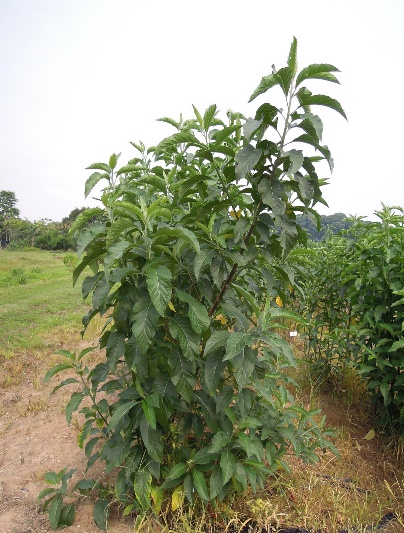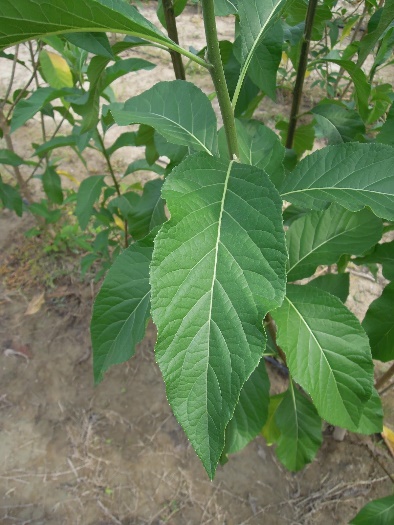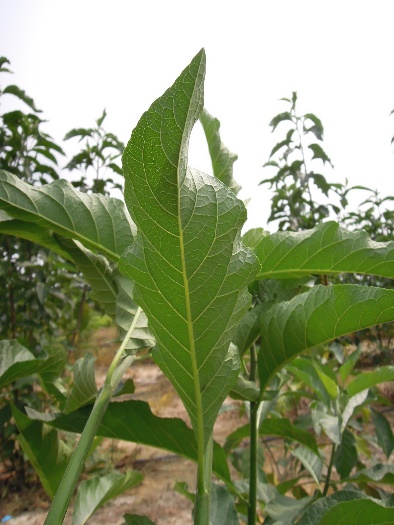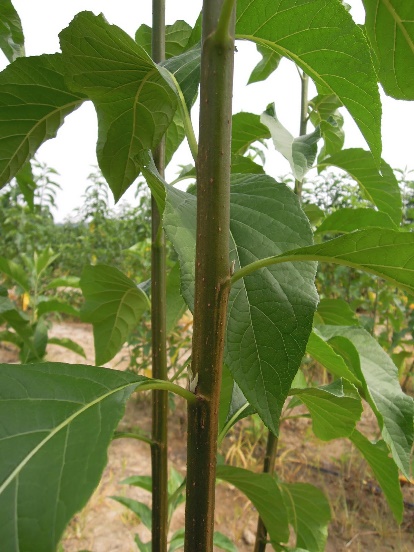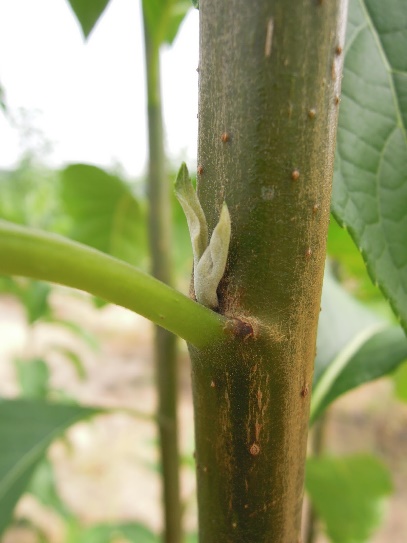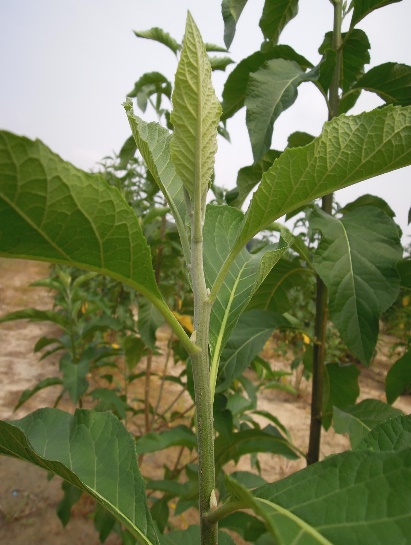Panjang hayat (bismillah) Leaves
Vernonia amygdalina Delile
Asteraceae
DEFINITION
Panjang hayat (Bismillah) leaves consist of the powder of dried leaves of Vernonia amygdalina Delile (Asteraceae).
SYNONYM
Gymnanthemum amygdalinum Dalile (Walp.), Bracheilema paniculatum R.Br., Cacalia amygdalina Kuntze, Cheliusia abyssinica Sch.Bip. ex A.Rich., Decaneurum amygdalinum DC., Vernonia adenosticta Fenzl ex Walp., Vernonia eritreana Klatt, Vernonia giorgii De Wild., Vernonia randii S.Moore, Vernonia vogeliana Benth., Vernonia weisseana Muschl [ 1 ].
VERNACULAR NAMES
Bitterleaf, common bitterleaf (English); panjang hayat, bismillah, pokok Afrika (Malay); fei zhou ku cha (Chinese); chedu aaku (Tamil) [ 2 ].
CHARACTER
| Colour | Yellowish green |
| Odour | Characteristic |
| Taste | Bitter |
IDENTIFICATION
Plant Morphology
V. amygdalina is a shrub or small tree 10 m high with densely pubescent young branches. The trunk diameter is 40 cm, bark is grey to brown, smooth and becoming fissured. The leaves are alternate, simple; stipules absent; petiole measuring 0.2–4 cm long; blade ovate-elliptical to lanceolate, 4–15 (–28) cm x 1–4 (–15) cm, cuneate or rounded at base, shortly acuminate at apex, margin minutely toothed to coarsely serrate, finely pubescent but often glabrescent, and pinnately veined. Inflorescence a head, arranged in terminal, compound, umbel-like cymes; stalk of head up to 1 cm long, pubescent; involucre cylindrical to broadly ellipsoid, 3–5 mm long, bracts 3–7-seriate, 1–4.5 mm long, appressed. Flowers are bisexual, regular, 5-merous, strongly exserted from the involucre; pappus consisting of outer linear, caducous scales measuring 1.5 mm long and of inner creamy or brownish bristles 4–7 mm long; corolla tubular, 5–8 mm long, whitish, glandular, with erect lobes; stamens with anthers united into a tube, with appendages at apex; ovary inferior, 1-celled, pubescent and glandular, style hairy, 2-branched. Fruit a 10-ribbed achene 1.5–3.5 mm long, pubescent and glandular, brown to black, crowned by the much longer pappus bristles. Seedling with epigeal germination [ 3 ].
Microscopy
Powdered material consists of anomocytic stomata found on the epidermis, with cuticular striae and sinuous cell outlines (abaxial surface), epidermal cell, parenchyma cell, fragments of spiral vessel cell, and three types of trichomes – simple multicellular, peltate glandular and irregular T-shaped glandular [ 2 , 4 , 5 , 6 ].
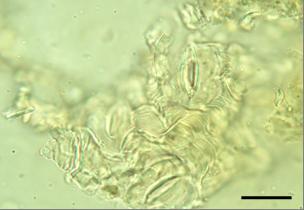
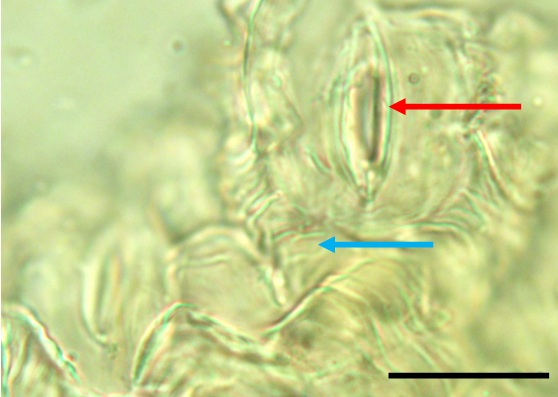
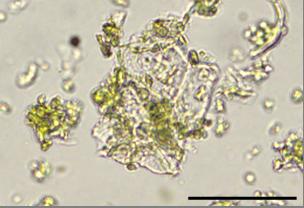
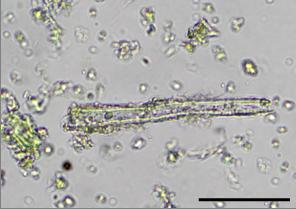
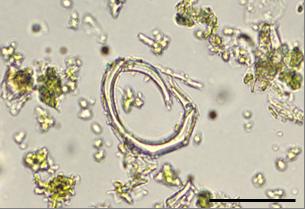
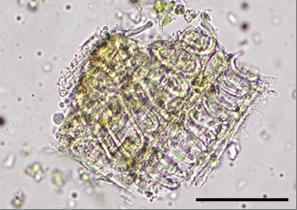
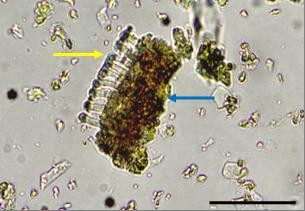
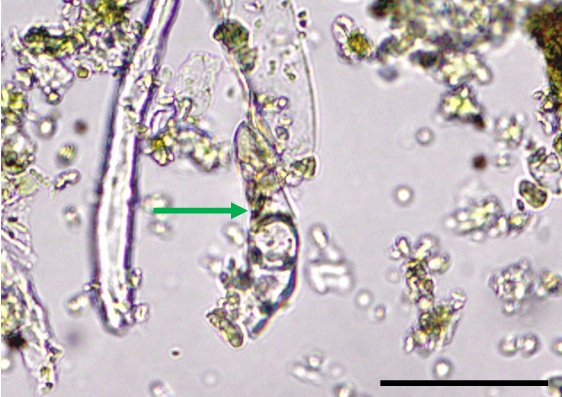
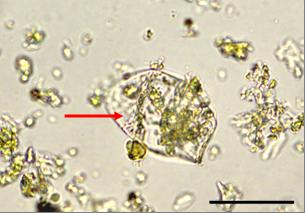
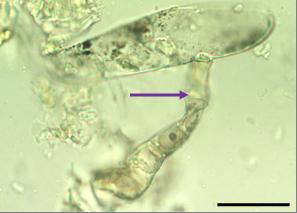
Figure 2 : Microscopic characters of V. amygdalina leaves powder of 0.355 mm size. (a) Stomata (magnification 100x); (b) anomocytic stomata (red arrow) with cuticular striae (blue arrow) (magnification 100x); (c) epidermal cells (magnification 40x); (d) parenchyma cell (magnification 40x); (e & f) fragment of spiral vessel cells (magnification 40x); (g) mesophyll palisade (yellow arrow) and spongy mesophyll (blue arrow) (magnification 40x); (h) simple multicellular trichome (green arrow) (magnification 40x); (i) head of peltate glandular trichome (arrow) (magnification 40x); (j) irregular T-shaped glandular trichome (purple arrow) (magnification 100x). [Scale bars : a & j = 100 µm; b-I = 50 µm]
Chemical Tests
Observation of solution after treatment with reagent:
| Test for the presene of saponins | Positive (foam) |
Thin Layer Chromatography (TLC)
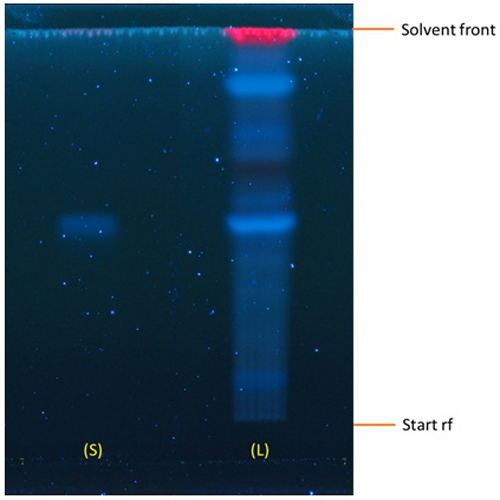
Figure 3 : TLC chromatogram of chlorogenic acid (S), ethanol extract of V. amygdalina dried leaves powder (L) observed under UV 366 nm.
| Test solution | Weight about 1.0 g of V. amygdalina dried leaves powder of 0.355 mm size in a 50 mL erlenmeyer flask. Add 10 mL of ethanol-water (75 : 25, v/v) and sonicate the mixture for 30 min at room temperature. Filter the mixture with filter paper into vials. Use the filtrate as test solution. |
| Standard solution | Dissolve chlorogenic acid standard [CAS no.: 327-97-9] in ethanol to produce a standard concentration of 0.2 mg/mL. |
| Stationary phase | HPTLC silica gel 60 F254, 10 x 20 cm |
| Mobile phase | Ethyl acetate : acetic acid : formic acid : water; (10 : 1.1 : 1.1: 2.3) (v/v/v/v) |
| Application |
|
| Development distance | 8 cm |
| Drying | Air drying |
| Detection | UV at 366 nm before derivatisation |
High Performance Liquid Chromatography (HPLC)
| Test solution | Weight about 1.0 g of V. amygdalina dried leaves powder of 0.355 mm size in a 50 mL erlenmeyer flask. Add 10 mL of ethanol-water (75 : 25, v/v) and sonicate the mixture for 30 min at room temperature. Filter the mixture with 0.22 µm nylon membrane filter into 1 mL vials. Use the filtrate as test solution. | |||||||||||||||||||||
| Standard solution | Dissolve chlorogenic acid standard [CAS no.: 327-97-9] in ethanol to produce a standard concentration of 0.2 mg/mL. | |||||||||||||||||||||
| Chromatographic system |
Detector: 325 nm Column: C18 (150 x 4.6 mm, 3.5 µm) (Waters XBridge unless necessary) Column oven temperature: 25°C Flow rate: 0.5 mL/min Injection volume: 1 µL |
|||||||||||||||||||||
| Mobile Phase (gradient mode) |
|
|||||||||||||||||||||
| System suitability requirement |
Perform at least five replicate injections of the standard solution (0.2 mg/mL). The requirements of the system suitability parameters are as follow:
|
|||||||||||||||||||||
| Acceptance criteria |
|
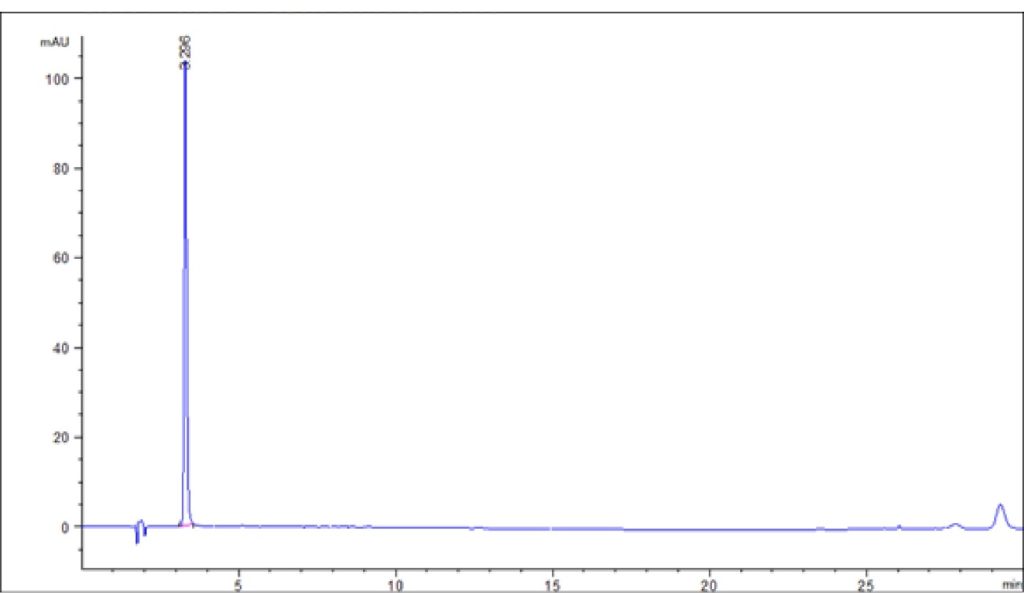
(a)
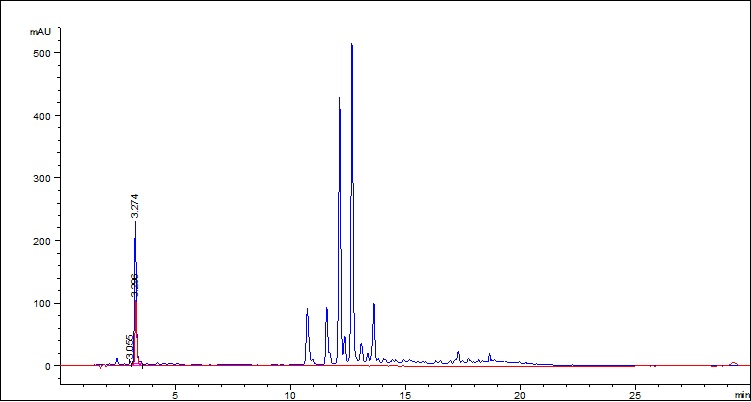
(b)
Figure 4 : Whole HPLC chromatogram of (a) chlorogenic acid standard solution (0.2 mg/mL) at tr = 3.296 min and (b) ethanol of V. amygdalina dried leaves powder showing peak corresponding to chlorogenic acid standard solution at tr = 3.274 min.
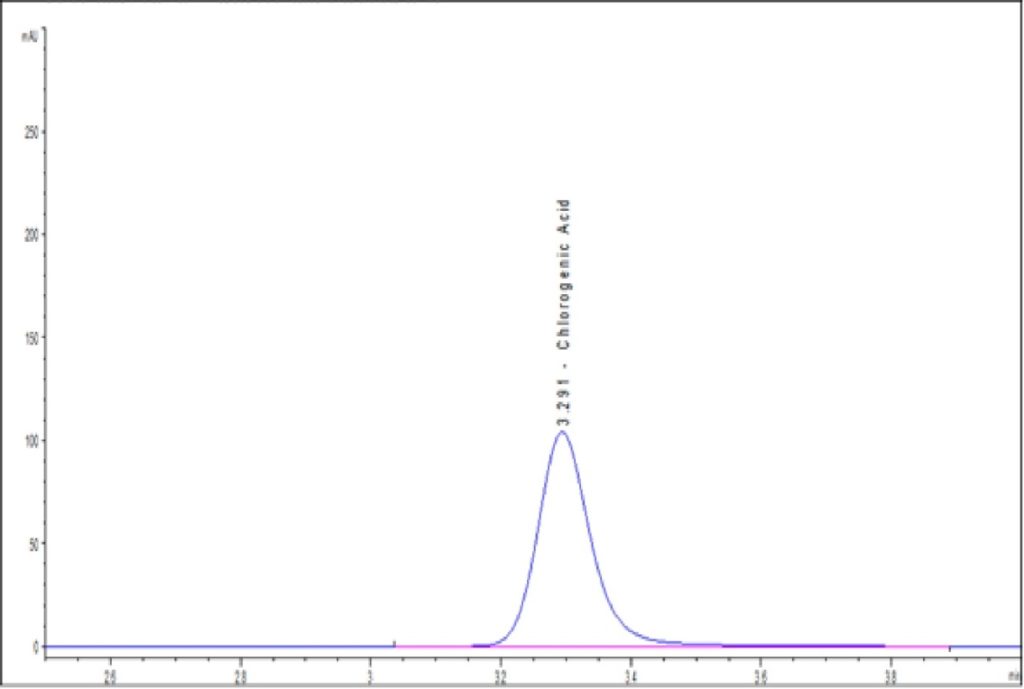
(a)
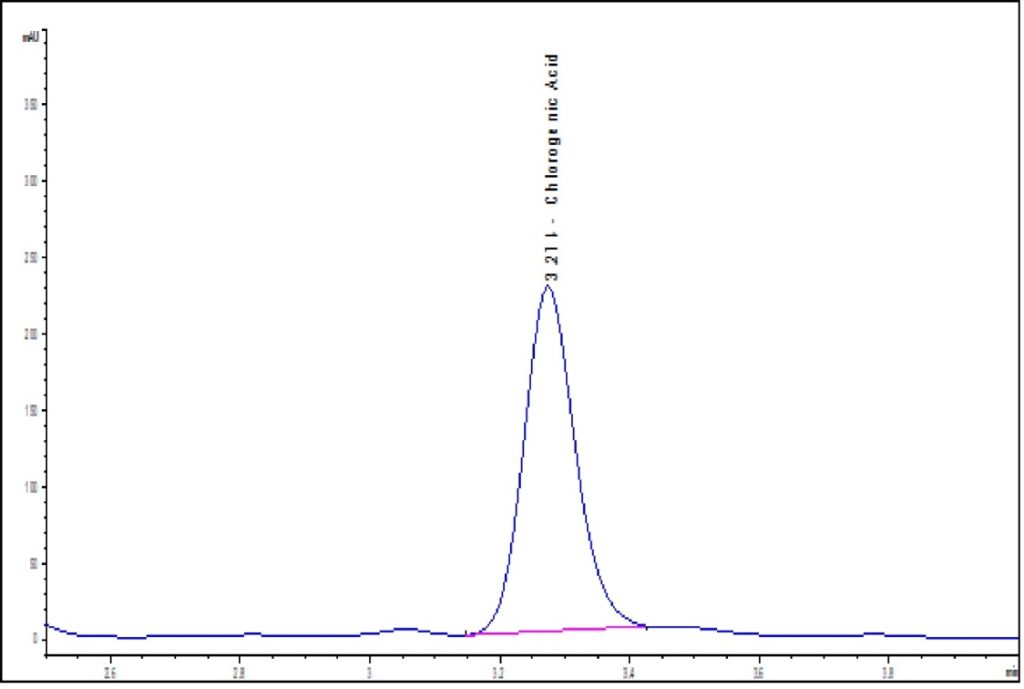
(b)
Figure 5 : HPLC chromatogram highlighting the elution of chlorogenic acid in (a) chlorogenic acid standard solution (0.2 mg/mL) and (b) ethanol extract of V. amygdalina dried leaves powder showing peak corresponding to chlorogenic acid standard solution at tr = 3.274 min.
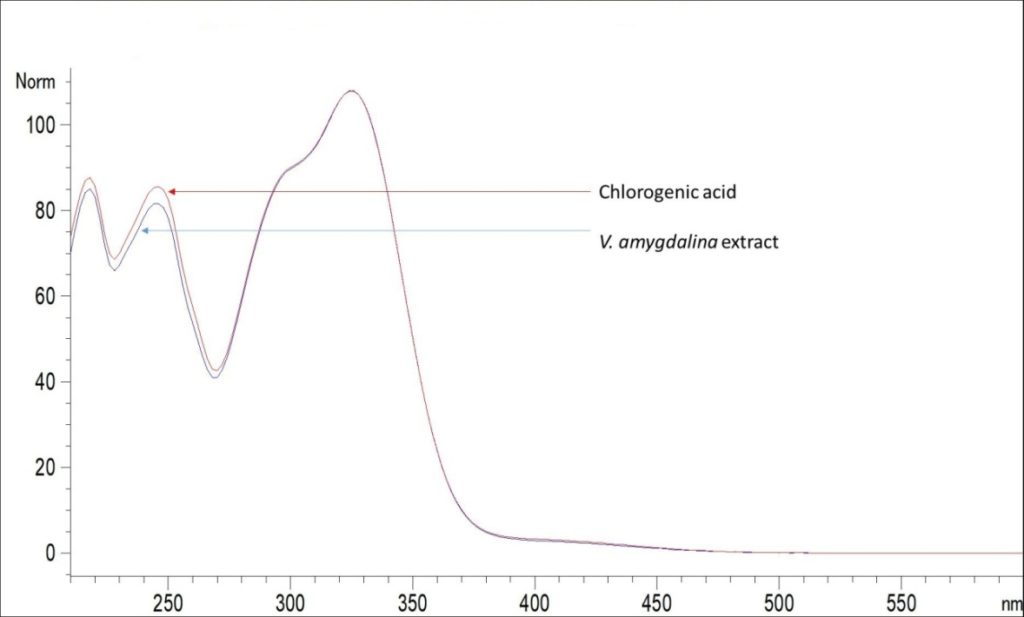
Figure 6 : UV spectrum of chlorogenic acid standard solution (0.2 mg/mL) and ethanol extract of V. amygdalina dried leaves powder.
PURITY TESTS
The purity test, except foreign matter test are based on V. amygdalina dried leaves powder of 0.355 mm particle size.
| Foreign Matter |
| Not more than 2% |
| Ash Contents | |
| Total ash | Not more than 12% |
| Acid-insoluble ash | Not more than 1% |
| Water soluble ash | Not less than 3% |
| Loss on Drying |
| Not more than 8% |
| Extractive Values | |
| Water-soluble extracts | |
| Hot method | Not less than 26% |
| Cold method | Not less than 15% |
| Ethanol-soluble extracts | |
| Hot method | Not less than 20% |
| Cold method | Not less than 16% |
SAFETY TESTS
The safety tests are based on V. amygdalina dried leaves powder of 0.355 mm particle size.
| Heavy Metals | |
| Arsenic | Not more than 5.0 mg/kg |
| Mercury | Not more than 0.5 mg/kg |
| Lead | Not more than 10.0 mg/kg |
| Cadmium | Not more than 0.3 mg/kg |
| Microbial Limits | |
| Total bacterial count | Not more than 105cfu/g |
| Total yeast and mould count | Not more than 104 cfu/g |
| Bile-tolerant gram negative | Not more than 104 cfu/g |
| Specific Pathogens | |
| Salmonella spp. | Absent in 25 g |
| Escherichia coli | Absent in 1 g |
| Staphylococcus aureus | Absent in 1 g |
| Pseudomonas aeruginosa | Absent in 1 g |
CHEMICAL CONSTITUENTS
Methanol (60%) extract of V. amygdalina dried leaves was found to contain phenolic (e.g. 1-,3-caffeoylquinic acid, chlorogenic acid, 5-caffeoylquinic acid and 4-caffeoylquinic acid, 1,3-dicaffeoylquinic acid, 1,4-dicaffeoylquinic acid, 3,4-dicaffeoylquinic acid, 3,5-dicaffeoylquinic acid, 1,5-dicaffeoylquinic acid, 4,5-dicaffeoylquinic acid, 1,4,5-tricaffeoylquinic acid, 1,3,5-tricaffeoylquinic acid and 3,4,5-tricaffeoylquinic acid) [ 7 ].
Methanol extract of V. amygdalina dried leaves was found to contain sesquiterpene lactone (e.g. vernolide and vernodalol) and (3-amino-5-methylhex-5-enyl-3-amino-6-methylhept-6-enyl terephthalate) [ 8 , 9 ].
Ethanol (70%) extract of V. amygdalina dried leaves was found to contain steroid saponins (e.g. vernoamyosides A, B, C and D) [ 10 ].
Ethanol (85%) extract of V. amygdalina dried leaves was found to contain sesquiterpene lactone (e.g. vernodalinol) [ 11 ].
Ethanol (99%) extract of V. amygdalina dried leaves was found to contain sesquiterpene lactone (e.g. vernolide and vernodalol) [ 12 ].
Ethyl acetate extract of V. amygdalina dried leaves was found to contain sesquiterpene lactone (e.g. vernodalin, vernolide and hydroxyvernolide) [ 13 ].
Lipid extract (hexane/isopropanol, 3 : 1) of V. amygdalina dried leaves was found to contain 12 fatty acids (e.g. tetradecanoic acid, 9-methyldodecanoic acid, hexadecanoic acid, 14-methylhexadecanoic acid, (Z,Z)-9,12-octadecadienoic acid, (Z,Z,Z)-9,12,15-octadecatrienoic acid, octadecanoic acid, eicosanoic acid, heneicosanoic acid, (Z,Z,Z)-6,9,12-octadecatrienoic acid, docosanoic acid and tetradocosanoic acid) [ 14 ].
Essential oils extract of V. amygdalina dried leaves was found to contain monoterpene (e.g. eucalyptol (1,8-cineole), β-pinene and myrtenal) [ 15 ].
MEDICINAL USES
Uses described in folk medicine, not supported by experimental or clinical data
Traditionally used to alleviate boils and shingles, relieve stomach ache, stomach indigestion, liver problem, postpartum and alleviate gout [ 16 ]. Decoctions of the leaves can be used to alleviate fever, diarrhoea, dysentery and cough as a laxative. The leaves can also be used for scabies and headache [ 17 ].
Biological and pharmacological activities supported by experimental data
Antimicrobial activity
Methanol (60%) extract of V. amygdalina leaves (25 mg/mL) showed antimicrobial activity against Bacillus subtilis with inhibition zone of 13 mm, Pseudomonas aeruginosa (13 mm), Proteus vulgaris (12 mm), Shigella dysenteriae (13 mm) and Staphylococcus aureus (10 mm) compared to streptomycin (B. subtilis: 20 mm; P. aeruginosa: 20 mm, P. vulgaris: 23 mm S. dysenteriae: 20 mm, S. aureus: 19 mm). [ 18 ].
Antimalarial activity
Ethanol extract of V. amygdalina leaves (100, 300 and 1000 mg/kg) was administered orally to female Swiss mice (20-22 g) two hours after being inoculated with 1 × 106 infected red blood cells on day 0. The extracts showed moderate antimalarial activity with effective dose at 50% (ED50) of 242.5 ± 4.8 mg/kg compared to chloroquine (ED50 of 10.67 mg/kg). [ 19 ].
Hepatoprotective effect
Methanol (90%) extract of V. amygdalina leaves (500 mg/kg) was pretreated to male Wistar rats (140-200 g) for 2 weeks before induction of hepatotoxicity using carbon tetrachloride (CCl4) simultaneously with extracts for another 3 weeks. The extracts showed significant (p < 0.05) decreased in alanine aminotransferase (ALT) (279.2 ± 14.6 U/L), aspartate aminotransferase (AST) (292.0 ± 85.6 U/L) and γ-glutamyl transferase (12.66 ± 5.01 U/L) compared to CCl4-treated group (ALT: 378.2 ± 32.3 U/L; AST: 453.0 ± 29.9 U/L; γ-GT: 35.90 ± 14.23 U/L) [ 20 ].
Ethanol (96%) extract of V. amygdalina leaves (100 mg/kg) was administered orally to male Wistar rats (10-12 weeks old) one hour after induction of hepatotoxicity using combination of isoniazid (INH) and rifampicin. Significant increase of ALT level at day 7 indicating the damage of the liver. At day 35, the ALT level decreased from day 7 (63.01 ± 3.01 U/L to 47.37 ±4.89 U/L) comparable to silymarin treated group (54.56 ± 7.88 U/L to 46.57 ± 5.80 U/L) [ 21 ].
Haemostatic activity
Aqueous extract of V. amygdalina leaves (5 mg/mL) administered orally to diabetic male albino rats (130 – 150 g) showed significant (p < 0.05) reduction in the bleeding time (1.3 ± 0.4 min) and clotting time (2.6 ± 0.3 min) compared to untreated control group (bleeding time: 4.6 ± 0.5 min; clotting time: 5.2 ± 0.9 min) [ 22 ].
Clinical studies
A study involving 41 patients (8 excluded) (aged 13 – 60) who were having malaria were selected to examine the efficacy of an infusion of fresh V. amgydalina leaves. The patients were given 1 L of freshly made infusion and were asked to take it 4 times daily (each time taken is 250 mL) for 7 days. The patients were follow-up for 28 days or until an endpoint was reached. 67% patients had an adequate clinical response at day 14 and no patients developed severe malaria. Complete clearance of parasite were reported in 32% (7 of 22 patients) at day 14, and of these, recrudescence reported in 71% (5 patients). No clinically significant changes were reported, except the reduction in hemoglobin between days 0 to day 28. No severe adverse events were reported [ 23 ].
SAFETY INFORMATION
Preclinical studies (Toxicology studies)
5-days toxicity
Aqueous extract of V. amygdalina dried leaves powder administered orally to male albino rats (130 – 150 g) once daily for five days showed no mortality with lethal dose at 50% (LD50) > 5000 mg/kg [ 22 ].
14-days toxicity
Aqueous extract of V. amygdalina dried leaves powder (5000 mg/kg) was administered orally to female Sprague dawley rats (250 – 300 g; 8 – 12 weeks old) at a single dose and were observed daily for 14 days. No mortality were observed throughout the study with (LD50 > 5000 mg/kg [ 24 ].
28-days toxicity
Aqueous extract of V. amygdalina leaves (600 mg/kg) was administered orally to 50 females and 50 males Wistar rats (6 – 8 weeks old) daily for a duration of 28 days. One death was observed at day 26 due to cannibalism caused by wounds. No pathological gross necropsy findings were detected and no significant findings on the hematological. Kidney congestion was observed in histopathology findings and no significant lesion were found in the liver, small intestines and heart [ 25 ].
Acute oral toxicity
Oral single dose acute toxicity study on female Sprague Dawley rats (aged between 8 and 12 weeks old) using aqueous extract of V. amygdalina leaves showed no toxic effect on the parameters observed, including behaviours, body weight, food and water intake. All rats were observed for 14 days prior to necropsy. No death was found throughout the study period. Necropsy revealed no significant abnormality but several histological lesions were found. Approximate lethal dose (LD50) is less than 2,000 mg/kg body weight [26].
Others (Adverse reaction, contraindication, side effect, warning, precaution)
Information and data have not been established.
DOSAGE
Information and data have not been established.
STORAGE
Store below 30°C. Protect from light and moisture.
REFERENCES
- The Plant List [internet] Vernonia amygdalina: 2013 [cited on April 2018]. Available from: www.theplantlist.org
- Ahlam SE, Bouran IA. Microscopial studies on the leaf and petiole of Vernonia amygdalina Del. Pelagia Research Library 2011:2(2):398-406.
- Grubben GJH. Plant Resources of Tropical Africa: Vegetables. Wageningen: PROTA Foundation. 2004:2.543-546.
- Kemka-Evans CI, Okoli B, Nwachukwu CU. Epidermal studies of three species of Vernonia in Southern Nigeria. Biodiversitas 2014:15(2):137-141.
- Nwosu SI, Stanley HO, Okerentugba PO. Occurrence, types, and location of calcium oxalate crystals in Vernonia amygdalina (Asteraceae). International Journal of Science and Nature 2013:4(3):533-537.
- Oladele FA. Leaf epidermal features in Vernonia amygdalina and Vernonia cinerea. Nigerian Journal of Botany 1990:3:71-77.
- Johnson CE, Lin LZ, Harnly JM, Oladeinde FO, Kinyua AM, Michelin R, Bronner Y. Identification of the phenolic components of Vernonia amygdalina and Russelia equisetiformis. Journal of Natural Products 2011:4:57-64.
- Abay SM, Lucantoni L, Dahiya N, Dori G, Dembo EG, Esposito F, Lupidi G, Ogboi S, Ouedrago RK, Sinisi A, Orazio T-S, Yerbanga RS, Bramucci M, Quassinti L, Ouedraogo JB, Christophides G. Plasmodium transmission blocking activities of Vernonia amygdalina extracts and isolated compounds. Malaria Journal 2015:14:288.
- Zenebe MM, Dessie BK, W/Hana GG. Isolation, structural elucidation, and bioactivity studies of leaf extract of Vernonia amygdalina. American Journal of Applied Chemistry 2015:3(1):14-20.
- Quasie O, Zhang YM, Zhang HJ, Luo J, Kong LY. Four new steroid saponins with highly oxidized side chains from the leaves of Vernonia amygdalina. Phytochemistry Letters 2016:15:16-20.
- Luo X, Jiang Y, Fronczek FR, Lin C, Izevbigie EB, Lee KS. Isolation and structure determination of a sesquiterpene lactone (vernodalinol) from Vernonia amygdalina Pharmaceutical Biology 2011:49(5):464–470.
- Erasto P, Grierson DS, Afolayan AJ. Bioactive sesquiterpene lactones from the leaves of Vernonia amygdalina. Journal of Ethnopharmacology 2006:106:117–120.
- Jisaka M, Ohigashi TH, Takegawa K, Huffman MA, Koshimizutt K. Antitumoral and antimicrobial activities of bitter sesquiterpene lactones of Vernonia amygdalina, a Possible Medicinal Plant Used by Wild Chimpanzees. Bioscience, Biotechnology, and Biochemistry 1993:57(5):833-834.
- Erasto P, Grierson DS, Afolayan AJ. Evaluation of antioxidant activity and the fatty acid profile of the leaves of Vernonia amygdalina growing in South Africa. Food Chemistry 2007:104: 636-642.
- Asawalam EF, Hassanali A. Constituents of the essential oil of Vernonia amygdalina as maize weevil protectants. Tropical and Subtropical Agroecosystems 2006:6:95-102.
- Mustapha NM, Nik Mahmood NZ, Mohd Ali NA, Haron N. Khazanah Perubatan Melayu. Tumbuhan Ubatan. Vol.II. Selangor:Institut Penyelidikan Perhutanan Malaysia. 2017:80-83.
- Fomum FU. Vernonia amygdalina Delile [Internet]. Wageningen, Netherlands: PROTA (Plant Resources of Tropical Africa; 2004 [cited 2015 April 24]. Available from:https://www.prota4u.org/database/protav8.asp?g=pe&p=Vernonia+amygdalina+Delile.
- Akinpelu DA. Antimicrobial activity of Vernonia amygdalina Fitoterapia 1999:70:432-434.
- Omoregie ES, Pal A. Antiplasmodial, antioxidant and immunomodulatory activities of ethanol extract of Vernonia amygdalina leaf in Swiss mice. Avicenna Journal of Phytomedicine 2016:6(2):236-247.
- Adesanoye OA, Farombi EO. Hepatoprotective effects of Vernonia amygdalina (Asteraceae) in rats treated with carbon tetrachloride. Experimental and Toxicologic Pathology 2010:62:197-206.
- Iwo MI, Sjahlim Sl, Rahmawati SF. Effect of Vernonia amygdalina Leaf ethanolic extract on intoxicated male wistar rats liver. Scientia Pharmaceutica 2017:85(16).
- Oguwike FN, Offor CC, Onubeze DPM, Nwadioha AN. Evaluation of activities of bitterleaf (Veronia amygdalina) extract on haemostatic and biochemical profile of Induced Male Diabetic Albino Rats. IOSR Journal of Dental and Medical Sciences 2013:11(2):60-64.
- Challand S, Willcox M. A clinical trial of the traditional medicine Vernonia amgydalina in the treatment of uncomplicated malaria. The Journal of Alternative and Complementary Medicine 2009:15(15):1231-1237.
- Zakaria Y, Zainul Azlan N, Nik Hassan NF, Muhammad H. Phytochemicals and acute oral toxicity studies of the aqueous extract of Vernonia amygdalina from state of Malaysia. Journal of Medicinal Plants Studies 2016:4(3): 1-5.
- Nabukenya I., Rubaire-Akiiki C., Mugizi D., Katerengga J., Olila D, HÖglund J. Sub-acute toxicity of aqueous extracts of Tephrosia vogelii, Vernonia amygdalina and Senna occidentalis in rats. Natural Products Chemistry and Research 2 2014:2(5):143. Available from: doi: 10.4172/2329-6836.1000143.
- Nor Azlina Z, Terence Tan YC, Siau Thien C, Nur Salsabeela R, Pusphawathy K, Raja Nazatul Izni RSH, Wan Nurul Nadia WS, Zubaira K, Lalitha Suganthi S. Acute oral toxicity study of selected Malaysian medicinal herbs on Sprague Dawley rats. Institute for Medical Research, Ministry of Health; 2021. Report no.: NON-GLP/2021/04/01.

